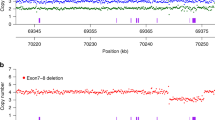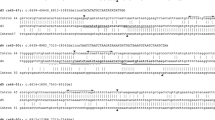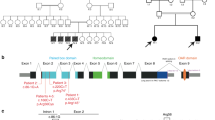Abstract
The gene for autosomal recessive proximal spinal muscular atrophy (SMA) has recently been mapped between D5S629 and D5S557. We report here a new single-locus microsatellite A31 (D5S823) and two multicopy microsatellites 97T-CA and 95/23-CA. The marker A31 maps to the region of overlap between YACs y116, y55 and y122, distal to D5S629; 97T-CA originates from a cosmid corresponding to the STS 97T, localized distally to A31, while 95/23-CA derives from a cosmid corresponding to the STS 97U, localized proximally to D5S557. We tested all our key recombinant families with these markers. In one type I/II SMA family, a recombinant was found that placed the SMA locus distal to D5S823. Homozygosity mapping in a consanguineous type I SMA family indicates that the SMA gene lies proximal to 95/23-CA. Thus, the two new markers, A31 and 95/23-CA further refine the SMA gene to an approximately 750-kb interval.
Similar content being viewed by others
Introduction
The autosomal recessive proximal spinal muscular atrophy (SMA) candidate region on 5q11.2-13.3 has been narrowed to a region of about 1.4 Mb between the loci D5S435 and D5S557 [1–6]. More recently, a new marker, D5S629, which is more distal to D5S435 has been defined as the closest proximal border of the SMA region [7]. This region containing the SMA gene is still large complicating the search for the gene. Apart from the size of the region, there are several unusual features of this part of the genome. It contains multiple copies of various loci [2, 9–12], chromosome-specific repeats [2–4, 13] and is highly unstable in YACs [2, 8, 9]. It also appears to encode a large number of cDNAs [authors’ obs.]. Due to this complexity, it is imperative to narrow the area containing the SMA gene.
Materials and Methods
Family Assessment
The 7 key recombinant families have been previously reported [4, 5]. All patients with proximal SMA were carefully investigated and diagnosis was performed according to the criteria defined by the International SMA Consortium [14].
Construction of Cosmid Libraries from YACs
High-molecular-weight YAC DNA (about 7.5 µg/plug) was prepared in 1.5% low-melting agarose by standard methods [15] and stored in 0.5 MEDTA. The plugs were washed 3 times in 1 × TE at 50 °C, then partially digested with Sau3AI (about 0.06 U/plug). For the analytical test, one plug was melted in a final volume of 250 µl containing enzyme reaction buffer. Aliqouts of 50 µl were directly transferred into tubes containing 5 µl of 0.5 M EDTA at 0, 5, 10, 15 and 20 min. These were separated on 0.3% agarose gel at 30 V overnight. The digestion times giving the best sizes (about 20–40 kb) were between 5 and 10 min. The preparative digest was performed with 3 plugs using digestion times of 5,7.5 and 10 min. The enzyme was immediately inactivated with EDTA (15 mM final concentration) and the plugs were melted at 68°C for 10 min. The dephosphorylation (5 U alkaline phos-phatase/plug, Boehringer) and agarase treatment (2U agarase/plug, Calbiochem or Eurogentech) were performed simultaneously at 37°C for 2 h. The alkaline phosphatase inactivation was achieved by adding 15 mM EDTA and heating the reaction at 68°C for 10 min. NaCl was added to a final concentration of 100 mM, then the DNA was extracted twice with phenol, pH8 (no chloroform!) and twice with ether (saturated with distilled water). The DNA was precipitated with 1/10 vol 3 M sodium acetate, pH 6 and 2.5 vol ice-cold ethanol, placed on ice for 5 min, and then the DNA was pelleted at 5,000 rpm in an Eppendorf centrifuge for 20 min. The DNA was pooled and resuspended in 6 µl 1 × TE. The DNA concentration was tested by dropping 0.5 µl of the sample on an ethidium-bromide-stained agar plate. About 2–4 µg of YAC DNA were ligated to 1–2 µg cosmid DNA SuperCosl (Stratagene) in a total volume of 12 µl overnight at 14°C. The vector DNA was prepared as recommended by the supplier. 4 µl of the ligation mix were packaged with Gigapack Gold (Stratagene) and plated out on two large plates (222 × 222 mm). About 30,000 colonies/plate were obtained. Human clones were identified by hybridization with radioactively labelled human pool DNA mixed with an Alu probe.
Screening of a Chromosome-5-Gridded Cosmid Library with STSs Derived from the SMA Region
The PCR product of different STSs from the SMA region [2] were radioactively labelled by random priming, competed with 200 µg human pool DNA/5 µg Alu probe/5 µg SuperCosl vector DNA and hybridized against gridded filters of the chromosome-5-specific cosmid library (Los Alamos). Filters were prehybridized for 4 h and hybridized overnight in 0.5 M sodium phosphate buffer pH 7.2/7% SDS/1 mM EDTA at 65°C and washed in 2 × SSC/0.1% SDS, 1 × SSC/0.1% SDS and 0.1% SSC/0.1% SDS at 65°C for 20 min each, then exposed on Kodak X-OMAT autoradiographies at −70°C for 2–5 days.
Identification and PCR Analysis of Simple-Sequence Repeats (SSRs)
This was carried out as previously described [4, 16]. The sequences have been deposited within the EMBL Data Library under the Accession No.: X76698 (A31), X76699 (97T-CA) X76700 (95/23-CA), X76701 (97U-CA).
Results and Discussion
Isolation and Characterization of New SSRs Derived from the SMA Region between the Loci D5S629 and D5S55 7
We constructed a cosmid library from the YAC yl 16 [2], and isolated 96 human clones which were hybridized with radioactively labelled CA/GT-ds DNA. Seven positive clones were obtained. From the cosmid C31, the new polymorphic SSR A31 (D5S823) was isolated. The cosmid was physically mapped to the overlapping region between YACs y116, y55 and y 122 by probing a Southern blot containing Eco-RI-digested YACs covering the SMA region, as well as genomic DNA from the somatic cell line PN/TS (which contains human chromosome 5) and HHW1064 (which contains a human chromosome 5 with a deletion of 5q11.2-q13.3). Thus, D5S823 lies distal to D5S629 (which was positive only for YACs y 116 and y55, but not y 122) and approximately 550 kb distal to D5S435.
The repeat motif, size of PCR product and PCR conditions are given in table 1. The allele distribution on the SMA chromosomes, which was determined in 310 chromosomes, is as follows: 128, (0.12); 130, (0.00); 132 (0.01); 134(0.02); 136 (0.64); 138 (0.08); 140 (0.04); 142 (0.01); 144(0.01); 146 (0.07); 148 (0.01). Similar frequencies were found on the normal chromosomes. The heterozygosity frequency is 54%.
To obtain additional clones from the region, we isolated cosmids from the chromo-some-5-specific Los Alamos library by hybridizing different STS-PCR products derived from the SMA region [2] against gridded cosmid filters.
From three different cosmids we isolated the following SSRs: 97T-CA, 95/23-CA and 97U-CA (table 1). The SSR 97T-CA ended at one side adjacent to an Alu repeat which is orientated with the 5′ end towards the (CA)n repeat. Therefore, the reverse primer is a 5′ Alu repeat sequence. Nevertheless, we obtained specific PCR products and the alleles showed Mendelian inheritance. Both markers, 97T-CA and 95/23-CA revealed a polymorphic multilocus pattern with up to 6 alleles. Since the evaluation of these complex patterns and the segregation analysis was often extremly difficult, no detailed analysis with respect to the distribution of alleles on normal and SMA chromosomes was performed. The marker 97U-CA was not polymorphic in 20 unrelated people.
Linkage Analysis in SMA Families
The new polymorphic marker A31 (D5S823) was tested against 7 multiplex recombinant families from Bonn and Ohio, who were recombinant with the closest flanking markers, D5S629 or D5S557. One of these families, OSU1, was recombinant for the marker A31 (D5S823). The two affected children inherited different alleles from their mother. All other proximal markers recombined as well, while the distal markers cosegregated with the SMA gene. These data were confirmed independently in Bonn and Ohio laboratories and indicate that the SMA gene lies within an approximately 850- to 1,000-kb interval flanked by the markers D5S823 and D5S557. The distance given is based on the YAC contigs reported by Kleyn et al. [2] and Carpten et al. [8]. However, because the YACs are unstable and possess frequent deletions, it is possible that the region is larger [8, 9].
Further markers, CATT-1 [10], C212 [9], Ag1-CA [11] and CMS1 [2] which are localized within the SMA candidate region did not recombine in any of these families.
The two other markers (97T-CA and 95/23-CA) revealed multiple copies within the SMA region. Due to the difficulty analyzing these complex markers, we only examined recombinant and consanguineous families. No clear recombinants were detected. However, in a type I SMA family in which the parents are first cousins, the marker 95/23-CA together with additional distal markers was heterozygous in the patient, whereas all markers proximal to 95/23-CA were homozygous. The most likely interpretation of these data is that a recombination occurred in the related grandfathers or the parents and that the SMA gene lies proximal to 95/23-CA. It is very unlikely that 6 higly polymorphic markers, Agl-CA, C212, D5S435, LAS96, D5S680 and D5S76, that were all full informative in the parents, are homozygous by chance, while all distal markers are heterozygous.
This finding indicates that the SMA gene is flanked by 95/23-CA and D5S823 and further refines the SMA candidate gene interval to a 750- to 900-kb interval. However the identification of further recombinants, especially on the distal side, would be useful to confirm the new SMA candidate region.
References
Soares VM, Brzustowicz LM, Kleyn PW, Knowles JA, Palmer DA, Asokan S, Penchaszadeh GK, Munsat TL, Gilliam TC: Refinement of the spinal muscular atrophy locus to the interval between D5S435 and MAP1B. Genomics 1993;15:365–371
Kleyn PW, Wang CH, Lien LL, Vitale E, Pan J, Ross BM, Grunn A, Palmer DA, Warburton D, Brzustowicz LM, Kunkel LM, Gilliam TC: Construction of a yeast artificial chromosome contig spanning the spinal muscular atrophy disease gene region. Proc Natl Acad Sci USA 1993;90:6801–6805
Francis MJ, Morrison KM, Campbell L, Grewal PK, Christodoulou Z, Daniels RJ, Monaco AP, Frischauf AM, McPherson J, Wasmuth J, Davies KE: A contig of non-chimeric YACs containing the spinal muscular atrophy gene in 5q13. Hum Mol Genet 1994;2:1161–1167
Wirth B, Pick E, Leutner A, Dadze A, Voosen B, Knapp M, Piechaczek-Wappenschmidt B, Rudnik-Schöneborn S, Schönling J, Cox S, Spurr NK, Zerres K: Large linkage analysis in 100 families with autosomal recessive spinal muscular atrophy (SMA) and 11 CEPH-families using 15 polymorphic loci in the region 5q11.2-q13.3. Genomics 1994;20:84–93
Burghes AHM, Ingraham SE, Kote-Jarai Z, Rosenfeld S, Herta N, Nadkarni N, DiDonato CJ, Carpten J, Hurko O, Florence J, Moxley RT, Cobben JM, Mendell JR: Linkage mapping of the spinal muscular atrophy gene. Hum Genet 1994;93:305–312
Steege van der G, Cobben JM, Brahe C, Osinga J, Zappata S, Scheffer H, Neri G, Ommen van GJB, Kate ten LP, Buys CHCM: Identification of key recombinants in multiplex SMA families. Genomics 1994;22:219–222
Clermont O. Burlet P, Burglen L, Lefebre S, Pascal F, McPherson J, Washmuth JJ, Cohen D, Paslier DL, Weissenbach J, Latrop M, Munnich A, Melki J: Use of genetic and physical mapping to locate the spinal muscular atrophy locus between two new highly polymorphic DNA markers. Am J Hum Genet 1994;54:687–694
Carpten JD, DiDonato C, Ingraham SE, Wagner-McPherson C, Nieuwenhuijsen BW, Wasmuth JJ, Burghes AHM: A YAC contig of the region containing the spinal muscular atrophy gene: Identification of an unstable region. Genomics 1994;24:351–356
Melki J, Lefebvre S, Burglen L, Burlet P, Clermont O, Millasseau P, Reboullet S, Benichou B, Zeviani M, Le Paslier D, Cohen D, Weissenbach J, Munnich A: De novo and inherited deletions of the 5q13 region in spinal muscular atrophies. Science 1994;264:1474–1477
Burghes AHM, Ingraham SE, McLean M, Thompson TG, McPherson D, Kote-Jarai Z, Carpenten JD, DiDonato C, Ikeda JE, Surh L, Wirth B, Sargent CA, Ferguson-Smith MA, Fuerst P, Moyzis RK, Grady DL, Zerres K, Korneluk R, MacKenzie A, Wasmuth JJ: A multicopy dinucleotide marker that maps close to the spinal muscular atrophy gene. Genomics 1994;21:394–402
DiDonato CJ, Morgan K, Carpten JD, Fuerst P, Ingraham, SE, Prescott G, McPherson JD, Wirth B, Zerres K, Hurko O, Wasmuth JJ, Mendell JR, Burghes AHM, Simard LR: Association between AG1-CA alleles and severity of autosomal recessive proximal spinal muscular atrophy. Am J Hum Genet 1994;55:1218–1229
Brahe C, Velona I, Steege van der G, Zappata S, Veen van EAY, Osinga J, Tops CMJ, Fodde R, Khan PM, Buys CHC, Neri G: Mapping of two new markers within the smallest interval harboring the spinal muscular atrophy locus by family and radiation hybrid analysis. Hum Genet 1994;93:494–501
Thompson TG, Morrison KE, Kleyn P, Bengtsson U, Gilliam TC, Davies KE, Wasmuth JJ, McPherson JD: High resolution physical map of the region surrounding the spinal muscular atrophy gene. Hum Mol Genet 1993;2:1169–1176
Munsat T, Davies KE: International SMA Consortium Workshop Report. Neuromusc Disord 1992;2:423–428
Anand R, Villasante A, Tyler-Smith C: Construction of yeast artificial chromosome libraries with large inserts using fractionation by pulsed-field gel electrophoresis. Nucleic Acids Res 1989:17:3425–3433.
Wirth B, Rudnik-Schöneborn S, Hahnen E, Röhrig D, Zerres K: Prenatal prediction in families with autosomal recessive proximal spinal muscular atrophy (5q11.2-q13.3): Molecular genetics and clinical experience in 109 cases. Prenat Diagn, in press.
Acknowledgements
We would like to thank Dr. Anne-Marie Frischauf for the chromosome-5-gridded cosmid filters and Dr. Larry Deavon for making the library available. We are grateful to the Deutsche Forschungsgemeinschaft and the MDA for funding this work.
Author information
Authors and Affiliations
Rights and permissions
About this article
Cite this article
Wirth, B., El-Agwany, A., Baasner, A. et al. Mapping of the Spinal Muscular Atrophy (SMA) Gene to a 750-kb Interval Flanked by Two New Microsatellites. Eur J Hum Genet 3, 56–60 (1995). https://doi.org/10.1159/000472274
Received:
Revised:
Accepted:
Issue Date:
DOI: https://doi.org/10.1159/000472274
Key Words
This article is cited by
-
Complete sequencing of the SMN2 gene in SMA patients detects SMN gene deletion junctions and variants in SMN2 that modify the SMA phenotype
Human Genetics (2019)
-
Applicability of Histone Deacetylase Inhibition for the Treatment of Spinal Muscular Atrophy
Neurotherapeutics (2013)
-
Deletions in the survival motor neuron gene in Turkish spinal muscular atrophy patients
Journal of Inherited Metabolic Disease (1996)



